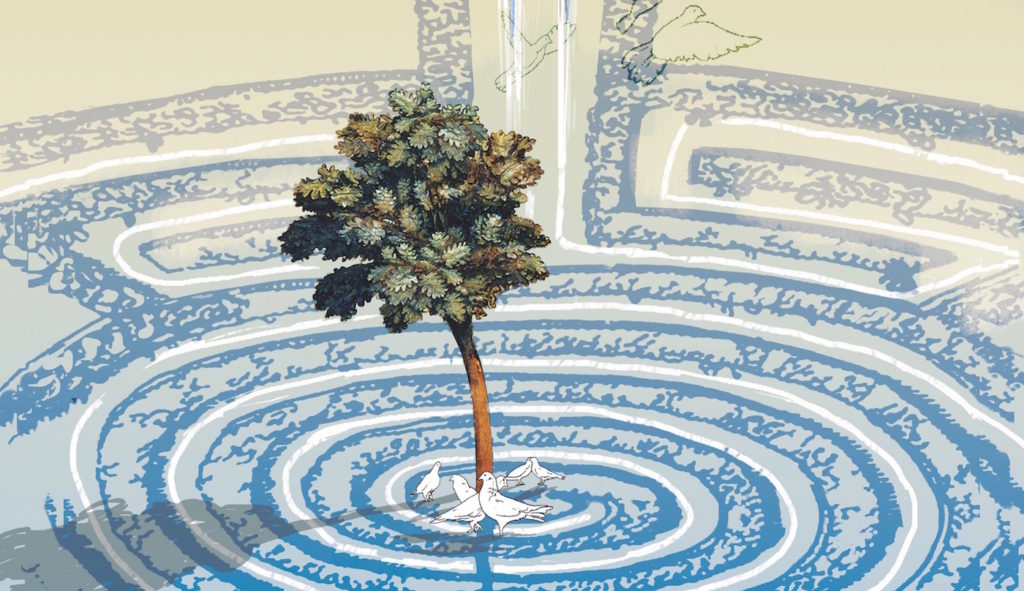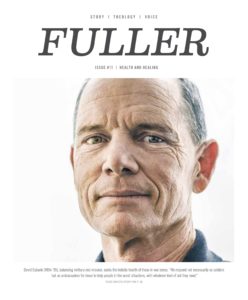
Healing, in its concrete sense of restoring or curing the sick or disabled, and even raising the dead, is one of the major themes in the narratives of Jesus. In a more general sense, healing could be equated to salvation through grace in Christ. It is the same for the Chinese cultural and philosophical tradition: healing is a metaphor for human spiritual growth; at the same time it is also understood as the concrete bodily cure by some metaphysical power through certain cultural-spiritual exercises. Therefore, the question of how to integrate the rich resources of the healing narrative in Confucian tradition, especially the Neo-Confucianism from the Song to Ming Dynasties (roughly 10th–17th centuries), into the Christian spirituality of healing in China, is important for the development of an indigenized Chinese theology. This essay will explore two inspirations from Neo-Confucian resources—namely, healing as an interpenetration between body and soul, and healing in and through Scripture reading—to sketch an intercultural spirituality of healing for ecumenical Christians.
HEALING AS INTERPENETRATION BETWEEN BODY AND SOUL
From its earliest beginnings, the Western anthropological tradition manifested a strong tendency to separate body and soul. Within the general Western cultural network, the anthropology of Christian theology has also been influenced by this distinction. The patristic theologians, for example, St. Augustine, understood salvation as a Platonic liberation of soul from the body. The medieval theologians followed the Aristotelian framework that the body is formed by the soul, even as modern European theology, dominated by the dualism of Descartes, believed that the body is an instrument of the soul in need of being disciplined by the conscious mind. Along these main streams of Christian tradition, the body enjoyed little significance in considerations of salvation, even if the word “salvation” originally in Greek means “to make well or whole” in its full sense.
Against this theological tendency, some 19th-century revivalists developed a more comprehensive understanding of the healing aspects of Christ’s salvation in their evangelical preaching. According to one of these renowned representatives, Albert Simpson, a Christ-centered “fourfold” gospel included the forgiveness of sins, the purification of the heart, the redemption of the body, and the future resurrection and eternal life.1 Arguably, this inclusive understanding is more in accord with the beliefs and practices regarding illness, health, and healing reflected in the Hebrew religion and New Testament writings. But the separation between the body and soul is still there, and in many Christian circles these are still regarded as two distinctive entities. How the healing of the Trinitarian God entails psychosomatic or mind-body interactivity is still in need of further elaboration.
What is being proposed here is that the gospel of mind-bodily healing in Christ finds a rich cultural resource in the Chinese context. Starting from the axial age in China, the dominant tradition has understood the human being as constituted by a single nature with interactive spiritual and bodily dimensions. As the Sage Mencius (孟子, 372–289 BC) famously articulated: “The essentials of the Noble Man’s character are humaneness, fairness, propriety, and wisdom, which are rooted in his mind. When they show themselves in his external appearance, their luster can be seen in his face, their fullness can be seen in his back, and go out into his four limbs. The four limbs reveal this without speaking” (仁义礼智根于心。其生色也,睟然见于面,盎于背, 施于四体,四体不言而喻).2 Furthermore, this psychosomatic understanding of human beings was not limited to Confucianism, but was a general cultural feature for all Chinese philosophical schools.
When it came to the period from the Song to Ming Dynasties, mainstream Neo-Confucianism began to syncretize the three religions of Confucianism, Daoism, and Buddhism. As a late Confucian, Mao Xinglai (茅星来, 1678–1748) concluded, “The Neo-Confucians did not want anymore to take knowing exhaustively the Scriptures and imitating the ancients as their priority, but mainly searching the truth psychosomatically with their body and soul” (程朱之学者,但求之身心性 命之间,不复以通经学古为事).3 For them, the purpose of philosophical inquiry is not for acquiring cognitive knowledge, which they despised as “little knowledge,” but for achieving a psychosomatic cure or healing, so that the soul and body come into harmony and peace with the “ultimate principle” of the universe.
Therefore, it is better to regard Neo-Confucianism as a theory and practice of spirituality than as a school of philosophy.4 Its basic understanding of the psychosomatic unity of human beings can be clearly summarized in three points:
1. The soul talks to the body. The Confucian Scripture, Great Learning, states: “Virtue makes a person shine; when the mind expands, the body is enriched. Therefore the Superior Man must make his will sincere.”5 The Neo-Confucians were enthusiastic in elaborating this classic text. For example, Xu Heng (许衡,1209–1281) interpreted it as follows: Those virtuous persons are upright in their hearts and therefore their bodies could be natural and comfortable; that is why virtues can enrich the body.6 The general principle upheld by Neo-Confucians is that a healthy body involves cultivation of the virtues of the heart.
2. The body talks to the soul. For Neo-Confucians, bodily gestures and behaviors, even bodily activities in accord with Confucian rites in all aspects of the daily life, could significantly influence one’s spiritual mood.7 As Zhu Xi (朱熹, 1130–1200) intimated: bodily gestures, clothing, ways of looking and respecting, and facial movement will exert influences on the spiritual situation of the heart; all of this bodily ordering outwardly is inwardly a spiritual reverence.8
3. This achieves union between the whole person and heaven. Once the body and soul are interpenetrated with each other, then the union with heaven, the highest spiritual goal for Neo-Confucians, is achieved in and through the whole person. That is the reason why Neo-Confucians always use the metaphor of “one body with heaven and earth” (与天地万 物为一体) as the highest spiritual realization of the perfect human. According to Wang Yangming (王阳明, 1472–1529), the perfect human is not a spiritual and disembodied human in heaven but is constituted by sensitive bodily feelings with all creatures.
To develop a Christian spirituality of healing or health in China, this psychosomatic unity of body and soul in Neo-Confucianism is not a hindrance or barrier but a rich cultural and spiritual resource. When discussing healing in Christ, it is the Spirit of Christ and Spirit of God who redeem and sanctify human creatures. And, as Jürgen Moltmann rightly points out, the Holy Spirit lays hold of the whole human being, em- bracing his feelings and his body as well as his soul and reason.9 Salvation in Christ by the Holy Spirit, as psychosomatic healing, could be rooted deeply in the Neo-Confucian spiritual or philosophical tradition. Furthermore, the saving or healing Spirit is not only a creative Spirit, but also the cosmic Spirit, in the sense that the body, soul, and whole person can only exist in relationship with other living beings in nature and in human society.10 This teaching is similar to the doctrine of Neo-Confucianism that the perfect human must be “one body with everything of heaven and earth.”
HEALING IN SCRIPTURE READING
In the Christian tradition, especially in the patristic and medieval periods, reading the Bible has been an important practice and integral activity through which human beings receive their healing in Christ.11 For the faithful, the Bible is the Word of God. The Word of which the Bible is testifying is also the creative Word by which God created the world in the beginning. The faithful take the bread of life from the Bible, because in the Bible, believers find their nourishment and strength. In and through sacred Scripture, the Father who is in heaven comes lovingly to meet his children and talks with them.12 Probably the most widely known and practiced Bible-reading tradition, lectio divina, has been praised as transformative, energizing, and divinizing.13 These questions then arise for Chinese believers and theologians: Are there indigenous resources, particularly in Neo-Confucianism, that discuss healing as occurring in the reading of sacred texts? If so, how could these be integrated into the Christian spirituality of healing through Bible reading in China?
Interestingly, the Neo-Confucians used precise medical terms to express the purpose of reading sacred texts. As Zhu Xi (朱熹) said: “It is not enough for one to read only part of the sacred texts to grasp the heavenly principle. It is like taking medicine. Only one dose cannot cure the illness. One needs to take the medicine one dose after another and the effects combine; then the medicine will work.”14
In the medical metaphor, the reading concerns not just intellectual understanding, but also involves existential union. Reading is eating and drinking. Zhu once showed the way of Scripture reading by a gesture in which he took packages of Chinese herbal medicine and said: “Taking medicine is not just to pack them together, but to cook it, and then drink it. Otherwise the medicine can do nothing to the illness.”15
For Neo-Confucians, the purpose of Scripture reading is to invite the “heavenly principle” (天理) to cure and occupy the “ill mind.” Scripture reading is a kind of physical and spiritual therapy. As Zhu said: “It is an illness of mind being trapped in indulgence, and not fully soaked with the heavenly principle. To cure this, one needs to read Scripture constantly and then to exhaust the principles. If he can do this constantly, his mind won’t be overwhelmed by evil desires and his inner self will be calm and firm.”16
In fact, Scripture reading is always a psychosomatic activity for Neo-Confucians. As Zhu writes: “The way of learning is getting knowledge by the mind and practicing it on the body.”17 Only by practicing the text unto oneself could the aim of Scripture reading—namely to change or heal the body and mind—be fulfilled.
Finally, the goal of Scripture reading is an existential union between the Scripture, the sage-writers, and, ultimately, the heavenly principle. This could be the healing of the whole person in its full sense. Zhu uses a vivid metaphor to express that union, saying: “The reader should bury his whole body in the Scripture. In his walking, living, sitting, and sleeping, his mind should have a single focus on the text with the aim to understand it fully. He shall not care that anything happened outside and only keep his mind on the Scripture. Only then can we call him a good reader.”18
Having investigated the psychosomatic healing of the whole person in reading the sacred texts in Neo-Confucianism, we can see how it could help to build a Christian spirituality of healing by Bible reading that is rooted in Chinese culture. This understands Bible reading not as an intellectual activity of learning historical facts or wise precepts, but as an encounter with the living principle of the universe: to read the Bible is to take the bread of life, drink the living water, and take the medicine that cures; to read the Bible is to enter a doorway to the transformation of the ill person; to read the Bible is to embark on a journey of healing of both mind and body; to read the Bible is to open up the whole person to union with the ultimate principle. All these could become basic elements of a Chinese Christian spirituality of healing that grows out of the rich cultural soil of Neo-Confucianism.
+ Read a response to this article called “Dualism, Intertextuality, and Qi.”


